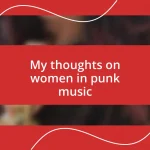Key takeaways:
- Protest songs unify listeners, evoke collective emotions, and serve as historical markers of social movements, such as Bob Dylan’s influence on civil rights.
- They highlight social injustices and reflect historical events, providing a soundtrack for protests and galvanizing grassroots movements across generations.
- Modern protest songs, amplified by social media, engage listeners in conversations about current issues, exemplified by tracks like “This Is America” and “Fight Song.”

Understanding protest songs influence
Protest songs have a unique power to galvanize collective emotion and create a sense of unity among listeners. I remember attending a rally where a well-known protest song flooded the air; the energy was palpable, and it felt like everyone was connected through the music. Isn’t it fascinating how a simple melody can ignite such passion and resonance within a crowd?
The influence of these songs often extends beyond their immediate context. For instance, when I hear Bob Dylan’s “The Times They Are a-Changin’,” I can’t help but reflect on the various civil rights movements that drew strength from his lyrics. It makes me wonder, how many changes in society’s fabric can we attribute to the emotional strength and articulate voice of a protest song?
Moreover, protest songs serve as historical markers, capturing the essence of specific moments in time. I often find myself revisiting songs that were anthems during pivotal social movements, and they instantly transport me back to those struggles. Does the emotional weight of these songs not compel us to confront our history and, perhaps, even motivate us to drive change today?

Historical significance of protest songs
Protest songs have often played a crucial role in recording historical events and influencing public opinion. I recall the first time I listened to “Fortunate Son” by Creedence Clearwater Revival; it felt like a raw reflection of the discontent during the Vietnam War era. Those lyrics not only expressed anger but also captured the frustration of a generation, serving as a soundtrack for protests and a rallying cry for social justice.
- They highlight social injustices and galvanize grassroots movements.
- Many protest songs have been tied to specific events, such as the Civil Rights Movement or anti-war protests, becoming timeless anthems.
- These songs resonate with emotions that transcend generations, making them a form of collective memory that inspires future action.
Throughout history, each protest song has its own narrative, much like pages in a history book, illustrating how music can reflect the triumphs and struggles of society. I often feel moved when I think about how these songs encapsulate moments of pain and hope, creating a bridge to understanding past and present struggles.

Modern protest songs and movements
The landscape of modern protest songs continues to evolve, deeply intertwined with current social movements like Black Lives Matter and climate activism. I recently found myself listening to “This Is America” by Childish Gambino, and it struck me how art can distill complex societal issues into a powerful commentary. How does music manage to capture both despair and hope in such a striking visual and auditory way?
I’ve noticed that artists today are using platforms like social media to amplify their messages, reaching audiences far beyond traditional boundaries. For example, songs like “Fight Song” by Rachel Platten have turned into anthems of resilience for many, often shared in personal narratives that highlight struggles against various forms of injustice. It’s incredible to see how a single song can become a rallying point for individuals searching for empowerment and solidarity.
What I find most compelling is how these modern protest songs invite listeners to join in a collective conversation about the world we live in. I remember posting a lyric from Hozier’s “Nina Cried Power” on my social media, and it sparked an enriching dialogue among friends. Isn’t it remarkable how these songs, through their melodies and lyrics, provide a soundtrack to our shared experiences and encourage us to imagine a better future?













